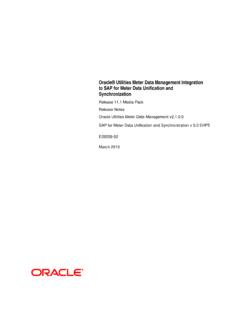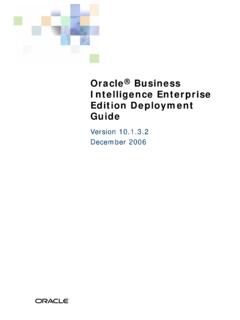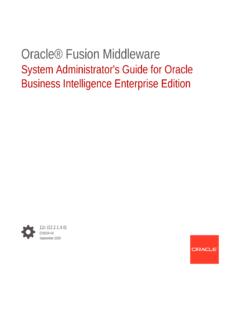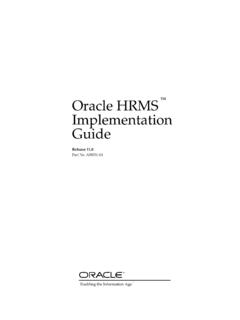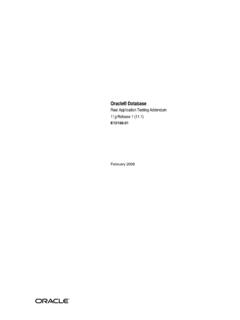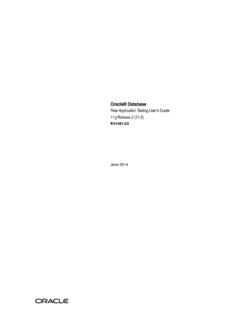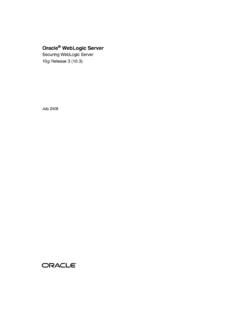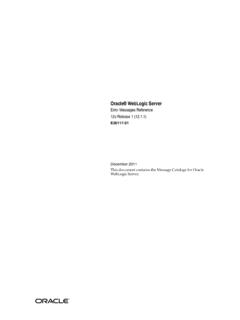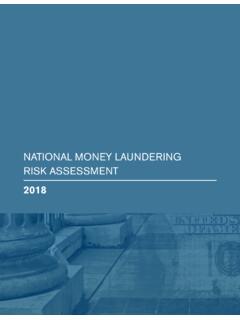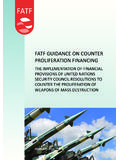Transcription of KYC 2.0 Risk Assessment Guide - Oracle
1 Know Your CustomerRisk Assessment GuideRelease January 2014 Know Your Customer Risk Assessment GuideRelease January 2014 Document Control Number: 9MN12-62110023 Document Number: Financial Services Software, Oracle Way Reston, VA 20190 Document Number: (January 2014)Copyright 2014, Oracle and/or its affiliates. All rights in No part of this publication may be reproduced, stored in a retrieval system, or transmitted in any form or by any means, electronic, mechanical, photocopying, recording, or otherwise without the prior written is a registered trademark of Oracle Corporation and/or its names may be trademarks of their respective Financial Services Software, Oracle WayReston, VA 20190 Phone: (703)478-9000 Fax: (703)318-6340 Internet: Risk Assessment Guide Release of Tables .. vAbout This Guide .. viiWho Should Use this this Guide is to Find More Used in this 1 KYC Risk 1 Workflow of KYC Risk Time Account Assessment of of Interested Identification Programme (CIP).
2 4 Calculation of List News Parameters of the Risk of the Customer's Effective Risk (CER)..5 Status of Risk by to after User and 2 Risk Assessment 9 Real-Time Account On-boarding Risk (RAOR)..9 Risk Assessment Assessment Assessment Risk Assessment Guide Release 3 Risk Assessment 13 Risk Assessment Weight AParameters .. 19 Real-Time Account On-boarding Risk Assessment Model Assessment Model Re-Review Risk Assessment Guide Release of TablesTable 1. Conventions Used in this 2. Risk Assessment 3. Sample Dynamic Weight 4. Real Time Account On-boarding Risk 5. Rule-based Assessment Model 6. Algorithm-based Assessment Model 7. Accelerated Re-Review Risk Assessment Guide Release of TablesKYC Risk Assessment Guide Release About This GuideThis Guide provides information related to risk assessments being performed on a customer to adhere to the norms of Know Your Customer (KYC). It also covers different risk models with the parameters considered for assessing the risk a customer poses to a financial institution.
3 This chapter focuses on the following topics: Who Should Use this Guide How this Guide is Organized Where to Find More Information Conventions Used in this GuideWho Should Use this GuideThe KYC Risk Assessment Guide is designed for a variety of Oracle Financial Services Enterprise Case Management users. Their roles and responsibilities, as they operate within the Oracle Financial Services KYC application, include the following: Business Analyst: A user in this role analyses and disposes the risk assessments promoted to a case. This user should understand how risk assessments are calculated and promoted to a case. A Business Analyst guides the Administrator to fine tune the parameters required for risk assessments. Relationship Manager: A user in this role verifies the risk assessments which are on hold status. This user is responsible for confirming customer information. KYC Administrator: This user is a manager for data center activities and application administration activities in a financial institution.
4 This user has access to configuration functionalities, and is responsible for configuring the required details for KYC process to execute. This user should have in-depth knowledge of all modules of KYC to perform the necessary administration and this Guide is OrganizedThe Oracle Financial Services KYC Risk Assessment Guide includes the following chapters: Chapter 1, KYC Risk Assessments, provides a brief overview of the KYC risk assessments. Chapter 2, Risk Assessment Model, details different risk models of KYC. Chapter 3, Risk Assessment Parameters, provides different parameters of the risk Assessment model. AppendixA, Parameters, describes the various parameters specific to model and customer Risk Assessment Guide Release About this GuideWhere to Find More InformationFor more information about Oracle Financial Services KYC, refer to the following documents: Enterprise Case Management User Guide : This Guide explains to business users how to access a risk Assessment promoted to a case and disposition the case.
5 Know Your Customer Administration Guide : This Guide provides comprehensive instructions for proper system administration, and the daily operations and maintenance of the KYC system. Configuration Guide : This Guide explains how the software works and provides instructions for configuring the Oracle Financial Services Behavior Detection Platform, its subcomponents, and required third-party software for operation. With respect to the FSDM specifically, it describes the steps by which data is processed and loaded (ingested) into the database. Data Interface Specification (DIS) Guide : This Guide identifies the super-set of data that Oracle Financial Services client supplies for data find additional information about how Oracle Financial Services solves real business problems, see our website at Used in this GuideTable1 lists the conventions used in this 1. Conventions Used in this GuideConventionMeaningItalics Names of books, chapters, and sections as references EmphasisBold Object of an action (menu names, field names, options, button names) in a step-by-step procedure Commands typed at a prompt User inputMonospace Directories and subdirectories File names and extensions Process names Code sample, including keywords and variables within text and as separate paragraphs, and user-defined program elements within text<Variable>Substitute input valueKYC Risk Assessment Guide Release 1 KYC Risk AssessmentsOracle Financial Services Know Your Customer assesses the risk associated with a customer by considering different attributes of the customer.
6 The attributes differ based on the customer type. The workflow of KYC enables financial institutions to perform Due Diligence, Enhanced Due Diligence, and continuous monitoring of risk model and parameters are derived from the following regulatory guidelines adopted around the world: International money laundering Abatement and Anti-Terrorist financing Act USA PATRIOT Act UK Proceeds of Crime Act 2002 JMLSG Guidance Third European money laundering DirectiveThis chapter discusses the following topics: Workflow of KYC Risk Assessments Customer Definitions Risk Assessment Process Status of Risk AssessmentsWorkflow of KYC Risk AssessmentsKnow Your Customer assesses the risk a customer poses to the bank or financial institution. KYC is a continuous process of Assessment and not a one time Assessment of a customer. Customers are assessed in different stages of their relationship with the bank or financial institution. Due Diligence is the process wherein the customers are risk assessed without consideration of third party verification like Identity Verification, Watch List and Negative News Search.
7 Customers are assessed based on parameters like occupation/industry, geography, Due Diligence is the process where third party verifications such as Identity Verification, Watch List, and Negative News Search are considered in addition to the Due Diligence parameters when risk assessing a monitoring of customers is performed through periodic review and accelerated different stages of the workflow of KYC are described in the following sections: Deployment Initiation Real Time Account On-boarding Account On-boarding Re-review2 KYC Risk Assessment Guide Release of KYC Risk AssessmentsChapter 1 KYC Risk AssessmentsDeployment InitiationThe Deployment Initiation workflow is executed for existing customers of a Bank or a Financial Institution (FI) after KYC is workflow ensures that all existing customers are being risk assessed and available in the KYC system for further Time Account On-boardingWhen a customer approaches a bank or an FI to open an account, this workflow is executed to assess the customer before opening an account.
8 This facilitates in the decision making for opening the On-boardingThis workflow is also called as default review. This workflow is executed when a new account is opened by a customer. New customers associated with a new account or an existing customer associated with a new account is considered for risk Assessment in this workflow. This workflow assesses the customers associated with an account opening date based on the value provided in Regular Processing parameter in the jurisdiction-specific Application Parameters is a continuous process of monitoring the customer. The following workflows ensure continuous monitoring of customers and their behavior. Periodic Re-review Accelerated Re-reviewPeriodic Re-reviewBased on the customer's risk score, the KYC system determines the next review date. If the customer poses high risk to the bank or FI, then the customer will be reviewed more often compared to medium or low risk customers. The re-review period is defined in the Risk Category table based on the ranges of the Customer Effective Risk (CER) score.
9 The system calculates the next re-review date after the closure of the risk assessments, both closed by system and closed after user review. The re-review date is then available in the Customer Review Detail table which is the repository of more information about how to provide values for this table, refer to the Configuration Periodic Review process is considered by KYC if the value defined in the Periodic Review parameter in the jurisdiction-specific Application Parameters table is Risk Assessment Guide Release 3 Customer DefinitionsChapter 1 KYC Risk AssessmentsAccelerated Re-reviewThe Accelerated Re-review workflow considers the changes in the information of the customer or the behavior detection results of the: primary customer interested party of the primary customer account of the primary customer account of the interested partyThe system checks for the change of information in the Change Log Summary table and generates risk assessments if it meets the also checks the behavior detection results for a customer based on the criteria defined and assesses the customers which match the criteria.
10 The values for the criteria are defined in the jurisdiction-specific Application Re-review Parameters table. For the details of different rules and its associated configurable parameters, refer to the Accelerated Re-Review Rules section of AppendixA, Parameters, on page example, this workflow assesses customers if there are any change logs associated to them or if there are any alerts of score X or closing action of a alert is X or count of alerts for a customer is X, where X is a configurable parameter which can be defined through the UI by the Admin user. The rules can be enabled or disabled for a particular jurisdiction. For KYC to assess customers via Change Log rules, the Change Log has to be enabled for the more information, refer to the Configuration DefinitionsThe customer type determines the parameters for KYC risk Assessment . It considers the following customer types: Individual Legal Entity Correspondent bankCustomers Primary Customer: The customer on whom the risk Assessment is being carried out.
